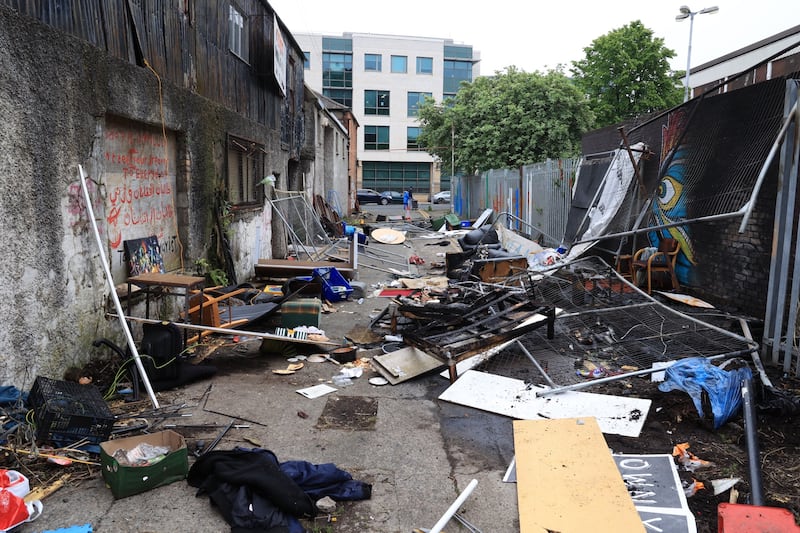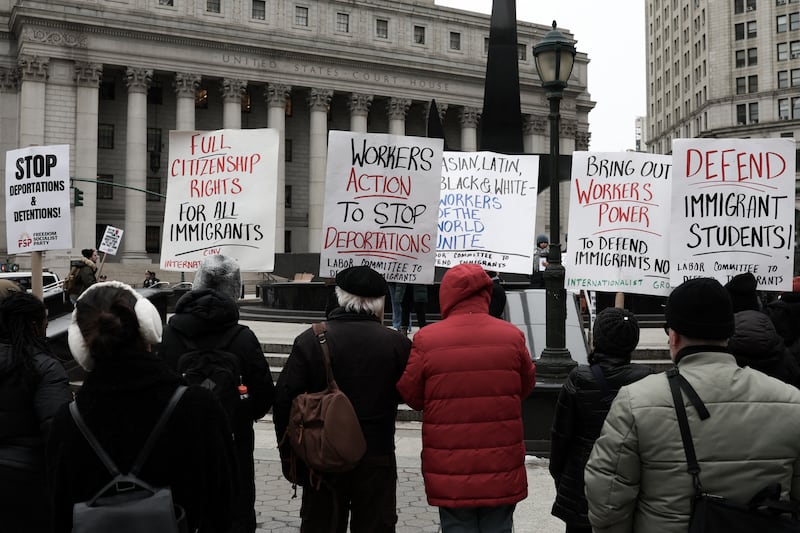Dublin Fire Brigade and gardai responded to a fire at the site of a makeshift refugee camp that had been the focus of angry protests on Friday night.
A number of homeless refugees had set up camp in a laneway on Upper Sandwith Street in the south inner city, attracting protests and counter protests that required a substantial Garda presence.
However, some time after the demonstration had ended, emergency services were alerted to a fire at the site.
While it was unclear late on Friday night how extensive the damage was, video posted to social media, and verified independently, appeared to show the entire encampment destroyed.
First group of migrants deported from US arrive in Costa Rica
Will dramatic immigration law reforms in Ireland change the number of people seeking asylum?
International protection overhaul an ‘important step’ in wider reform, Minister says
Asylum seekers to lose certain rights when appealing international protection refusal under new plans
A post on the Ireland Against Fascism feed read: “The end result of the destruction of the asylum seekers encampment tonight on Sandwith Street, Dublin 2.”

Earlier, crowds of anti- and pro-asylum-seeker demonstrators faced off in tense scenes at the site, which lies between dilapidated flats and boarded-up homes, separated only by a long line of public order gardaí.
The tensions followed some violent scenes on Thursday night at the same site, in what has become the latest simmering focal point of anti-immigrant hostility.
Shortly after 8pm, a line of uniformed gardaí were reinforced by members of the public order unit whose vans had taken up positions at either end of the street.
Each group, comparable in size, attempted to shout the other down – one chanting “Out! Out! Out!” against opposing calls of “Immigrants are welcome here.”
Anti-asylum-seeker protesters, mostly men and many wearing face coverings, hovered close to the Garda line while the overall demonstration attracted onlookers on surrounding street corners and from overlooking balconies.
Shortly before 10pm, gardaí attempted to escort the pro-refugee side away from the scene but were met with a human wall of protesters, seemingly intent on preventing their departure.
After a period of heightened tension, one man among the protesters appeared to broker a deal allowing gardaí to accompany the pro-immigrant group down Sandwith Street and on to Pearse Street.
Trinity College
However, public order officers and regular gardaí still had to usher the crowd along Pearse Street and the hostile exchanges only petered out at the College Green entrance to Trinity College.
Earlier, gardaí said investigations were ongoing after a violent altercation took place at the camp on Thursday evening.
Footage had emerged on social media of clashes on Thursday night between residents sleeping in tents and a group of people that approached the camp.
In the video, a man can be seen swinging a large pole at a number of people before being physically confronted. According to sources present at the time, at least two people were injured. No arrests were made and gardaí at Pearse Street station were investigating.
“Gardaí attended an incident that occurred at Sandwith Street on Thursday and no formal complaints were made,” said a statement.
“Gardaí are aware of footage being circulated on social media which occurred in the Sandwith Street area and an investigation into this incident is being carried out.”
It is understood that the migrant camp was set up during the May bank holiday weekend. According to local homeless outreach services, a number of asylum-seekers who were sleeping on the main road on Lower Mount Street in the vicinity of the nearby International Protection Office decided to move to an alley off Sandwith Street for safety reasons after incidents of intimidating behaviour from passersby. There are no more than 10 asylum-seekers staying in the camp.
Elizabeth Watson, a local Fianna Fáil representative, described the situation as “complex” and said the local community was “concerned” about the camp and the violence.
Mannix Flynn, an Independent councillor representing the south-east inner city, called for “balance” and for those living in the tented camp to be “protected”.













